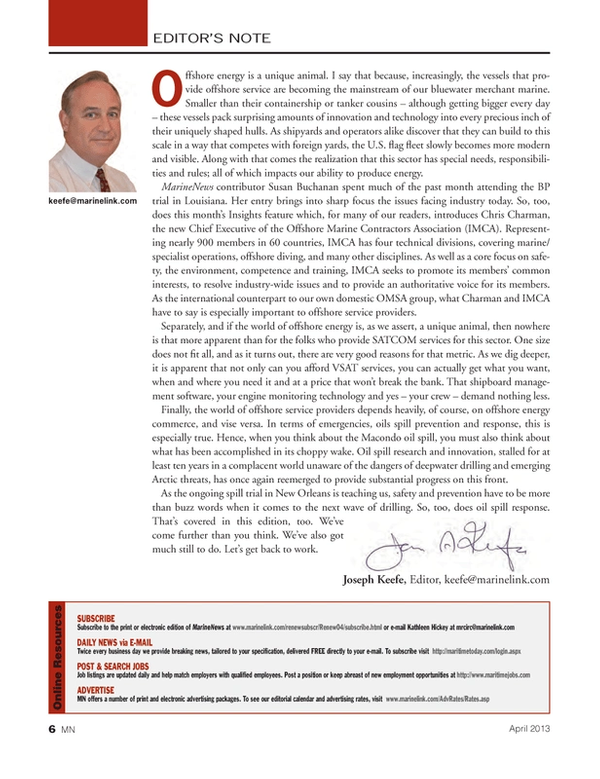
Editor's Note
Offshore energy is a unique animal. I say that because, increasingly, the vessels that provide offshore service are becoming the mainstream of our bluewater merchant marine. Smaller than their containership or tanker cousins – although getting bigger every day – these vessels pack surprising amounts of innovation and technology into every precious inch of their uniquely shaped hulls. As shipyards and operators alike discover that they can build to this scale in a way that competes with foreign yards, the U.S. flag fleet slowly becomes more modern and visible. Along with that comes the realization that this sector has special needs, responsibilities and rules; all of which impacts our ability to produce energy.
MarineNews contributor Susan Buchanan spent much of the past month attending the BP trial in Louisiana. Her entry brings into sharp focus the issues facing industry today. So, too, does this month’s Insights feature which, for many of our readers, introduces Chris Charman, the new Chief Executive of the Offshore Marine Contractors Association (IMCA). Representing nearly 900 members in 60 countries, IMCA has four technical divisions, covering marine/specialist operations, offshore diving, and many other disciplines. As well as a core focus on safety, the environment, competence and training, IMCA seeks to promote its members’ common interests, to resolve industry-wide issues and to provide an authoritative voice for its members. As the international counterpart to our own domestic OMSA group, what Charman and IMCA have to say is especially important to offshore service providers.
Separately, and if the world of offshore energy is, as we assert, a unique animal, then nowhere is that more apparent than for the folks who provide SATCOM services for this sector. One size does not fit all, and as it turns out, there are very good reasons for that metric. As we dig deeper, it is apparent that not only can you afford VSAT services, you can actually get what you want, when and where you need it and at a price that won’t break the bank. That shipboard management software, your engine monitoring technology and yes – your crew – demand nothing less.
Finally, the world of offshore service providers depends heavily, of course, on offshore energy commerce, and vise versa. In terms of emergencies, oils spill prevention and response, this is especially true. Hence, when you think about the Macondo oil spill, you must also think about what has been accomplished in its choppy wake. Oil spill research and innovation, stalled for at least ten years in a complacent world unaware of the dangers of deepwater drilling and emerging Arctic threats, has once again reemerged to provide substantial progress on this front.
As the ongoing spill trial in New Orleans is teaching us, safety and prevention have to be more than buzz words when it comes to the next wave of drilling. So, too, does oil spill response. That’s covered in this edition, too. We’ve come further than you think. We’ve also got much still to do. Let’s get back to work.
(As published in the April 2013 edition of Marine News - www.marinelink.com)
Read Editor's Note in Pdf, Flash or Html5 edition of April 2013 Marine News
Other stories from April 2013 issue
Content
- Editor's Note page: 6
- By the Numbers: Oil Spill Response page: 8
- Tampa Yacht Manufacturing’s TEMPEST 50-FAC page: 10
- Insights: Chris Charman Chief Executive, International Marine Contractors Association page: 12
- Safe Operations, Proven Results page: 18
- Key Salvage Issues for 2013 – and Beyond… page: 20
- Offshore Energy page: 22
- Medicare Set Asides – and You page: 24
- The Macondo Spill Trial page: 26
- Innovation Driven by Demand - Oil Spill Response page: 32
- A Tailored Approach to VSAT for Workboats page: 38
- Caterpillar’s Marine Center of Excellence page: 44
- Using Mediation: Eliminate Risk and Conserve Litigation Expenses page: 50
- JK Fabrication’s Emergency Towing Reel page: 54


